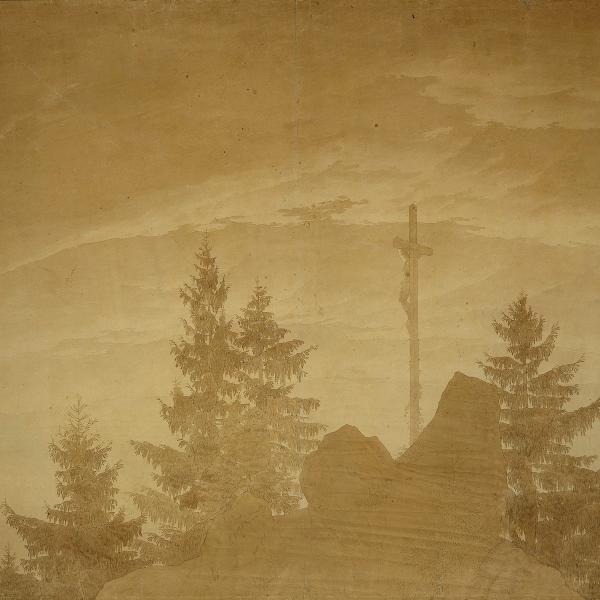The Cross in the Mountains
Artwork Details
- Title: The Cross in the Mountains
- Artist: Caspar David Friedrich (German, Greifswald 1774–1840 Dresden)
- Date: ca. 1806
- Medium: Brown ink and wash over pencil on wove paper
- Dimensions: Sheet: 25 3/16 × 36 1/4 in. (64 × 92 cm)
Framed: 33 7/16 in. × 43 5/16 in. × 1 3/16 in. (85 × 110 × 3 cm) - Classification: Drawings
- Credit Line: Kupferstichkabinett, Staatliche Museen zu Berlin (SZ CD.Friedrich 21)
- Curatorial Department: European Paintings
Audio

372. Nature and Faith (The Cross in the Mountains, 1806)
What made this composition so groundbreaking?
NARRATOR: One of the hallmarks of Romanticism, and of Friedrich’s work, is the commingling of nature and spirituality.
The Romantics sought out experiences of the sacred and transcendent, not only through traditional worship, but also through deep contemplation of the world around them.
JOANNA SHEERS SEIDENSTEIN: In this extraordinary work, you get this minimalism, this incredible kind of silhouetting of the cross, of the mountain top against the sky. And it's all in monochrome, only shades of brown.
NARRATOR: Co-curator, Joanna Sheers Seidenstein.
SHEERS SEIDENSTEIN: It gives it this incredibly breathtaking feeling. You get the sense of the setting sun, those, kind of, last rays of sunlight illuminating the sky. It’s just like the moment before it all goes dark.
To me, this is a work where he really does capture an experience and one that no matter what your own faith is, you don't even need the cross, right? You can just… you feel it. You feel this spirituality in this vision of the world.
NARRATOR: When Friedrich reworked this composition into an altarpiece, people were shocked and puzzled.
ALISON HOKANSON: Was he trying to elevate landscape to the level of a Christian allegory, which was unheard of and seen by some almost as sacrilege? Or is he trying to suggest that nature is somehow a path to God? And if so, where does the church fit into all of that?
NARRATOR: Co-curator, Alison Hokanson.
HOKANSON: These were all very real, very important, really central cultural questions at the time. So, although the images themselves can seem very simple, the meanings and the ideas that circulate around them are in fact very rich, very complex, and I think in some ways still relatable to us today.
NARRATOR: This artwork, Cross in the Mountains, and the ones in the next gallery, reflect the shifting understanding of God and religion during Friedrich’s time.
ANDREA WULF: The young Romantics embrace spirituality in a very different way. And that's something a lot of people today can maybe connect with them on another level.
NARRATOR: Romantic historian, Andrea Wulf.
WULF: What they believed is that the Reformation robbed religion of all color, scent, stories, poetry. Art was literally whitewashed off the church’s walls. That's how they saw it.
NARRATOR: The Reformation was a religious movement from the 1500s that challenged the authority of the Catholic church.
WULF: The Romantics wanted to inject feelings, imagination, beauty back into religion. So, they were not searching for God as such, but they were really searching for themselves as being a part of the universe.
JORDAN B. COOPER: You don’t really get the idea in his paintings that he's really concerned about teaching doctrine. That's not the point.
NARRATOR: Jordan B. Cooper is a Lutheran pastor, an adjunct professor of Systematic Theology, and a Ministry Fellow with Christian Union at Cornell University.
COOPER: Even though he has a Lutheran background and he has Lutheran commitments, that’s not really the point of art as a whole, per se.
HOKANSON: For me, one of the things that is significant is that he is picking up on major threads in the cultural conversation of his time. Religion and God and the church, all three different things, and how they should structure life and structure the life of the individual. And then nature and the natural world that we live in, and how all of those things relate.
COOPER: People were more moving into questions of experience, and I guess questions that were more practical. Things like what does it actually mean to live the Christian life? What is very common within Lutheran thought and Lutheran thought at that time is that paradox of the power of nature and the power of God revealed in nature, which kind of in some ways feels against us, but then also the beauty and grace that is displayed and given within it.
###
Music: Liszt, Liebestraum No. 3 in A-Flat